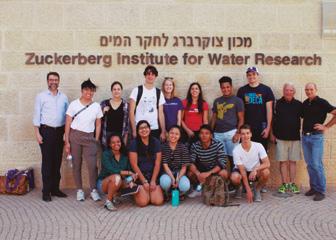
3 minute read
R&D SPOTLIGHT
NORTHWESTERN UNIVERSITY: INNOVATION AT THE WATERENERGY NEXUS: NEW COLLABORATION AIMS TO DEVELOP MORE EFFICIENT WATERENERGY TECHNOLOGIES
Whether it’s using massive amounts of water to generate electricity or using enormous quantities of energy to move, clean and heat water, water and energy are undeniably, closely and crucially connected.
A new multi-institutional program, called the U.S.-Israel Collaborative Water-Energy Research Center (CoWERC) seeks to tackle challenges and explore opportunities that sit at this water-energy nexus. Led by Northwestern University and BGN Technologies, the technology transfer company of Ben-Gurion University (BGU) of the Negev, CoWERC will research, develop and commercialize technologies with potential to reduce the energy needed for desalination, improve safe wastewater reuse and improve energy recovery.
Announced in March 2020, the consortium has a total budget of $18.4 million, including a $9.2 million grant over 5 years from the U.S.

Department of Energy, Israel’s Ministry of Energy and the Israel Innovation Authority. CoWERC is part of the U.S.-Israel Energy Center program, administered by the U.S.- Israel Binational Industrial Research and Development (BIRD) Foundation.
The highly collaborative consortium includes partners from leading research institutions, water utilities and private companies across the United States and Israel.
“CoWERC’s binational partnership allows us to link innovative processes and materials from both countries into new desalination system configurations,” said Northwestern’s Aaron Packman, who co-leads the collaboration. “We can use our combined expertise to tailor ion selectivity, for example, that increases water recovery from inland brackish waters and enables additional brackish water sources to be accessed in a cost-effective manner.”
Packman is a professor of civil and environmental engineering and director of Northwestern’s Center for Water Research. He co-leads CoWERC with Moshe Herzberg, a professor of environmental engineering at the Zuckerberg Institute for Water Research (ZIWR) at BGU.
The CoWERC team first will focus on nutrient and energy recovery from wastewater as well as high-recovery desalination. As water scarcity increases from population growth, environment degradation and climate change, researchers and governmental officials increasingly look toward marginal waters (municipal wastewater and brackish groundwater) as sources for drinking water and agriculture.


“There is a critical need to develop technologies to achieve maximal recovery when desalting brackish water,” said desalination expert Jack Gilron, who is a professor at ZIWR and the desalination project lead at CoWERC. “The current processes use a tremendous amount of energy or a very large land area to treat desalination concentrates. Employing energy saving membrane processes to recover more
water from these concentrates, and thereby reducing their volume, would reduce both the carbon footprint and the land footprint for inland desalination.”

For treating wastewater, CoWERC will evaluate an anaerobic membrane bioreactor (AnMBR) process, in which municipal wastewater are efficiently, biologically treated and separated with membranes from sludge. While this process is more sustainable than other common processes, it’s not without its challenges. A major disadvantage is that it produces liquid waste and sludge that are rich nutrients (reactive nitrogen and phosphorous), which create significant economic and environmental burdens for disposal.
“We believe we can turn this disadvantage into a benefit,” Herzberg said. “We are developing a new platform to extract and recover these nutrients, so they can be used as fertilizers.”

The CoWERC team also is finding new ways to recover energy, including biogas (methane) and nitrous oxide, a compound that is commonly used to boost horsepower in gasoline engines. The biogas composition produced by AnMBR can vary from 50% to 90% methane, which can be used for heating and electricity. The process, however, has significant disadvantages, including high costs, poor nutrient removal and high carbon emissions. This is another area that the team wants to confront with new technologies.

“Interestingly, urban wastewater contains more energy than the amount needed for its purification,” Herzberg said. “Our aim is to recover this energy, along with nutrients, and reuse the treated water.”










